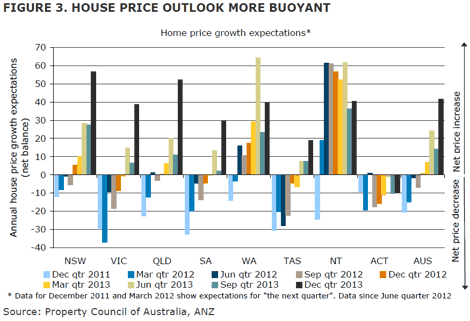Don't punt on Melbourne Cup Day relief - Bill Evans' call is February 2014 for next of two RBA rate cuts
Slowing economic growth and the weakening labour market will prompt the Reserve Bank of Australia to cut interest rates twice next year, according to Westpac chief economist Bill Evans.
Bill Evans tips rate cuts in February and May 2014.
“We expect deteriorating conditions abroad, softening confidence and more signs of weakness in local labour markets to see the RBA lower rates again next year,” Mr Evans said.
Evans' updates are always eagerly followed.
He was the first noted economist to tip the RBA to begin its current rate cutting cycle which commenced in November 2011.
Evens tipped it in mid-2011 when other economists did not foresee a rate cut and some were even forecasting rates to rise.
He tips the 2% cash rate will hold from May throughout the remainder of 2014.
The most recent survey by Bloomberg indicated 27 of 34 economists tipping the cash rate to remain on hold in November. That drops to 24 for keeping things the same at the December meeting.
The NAB expect the one cut in the first quarter of 2014.
Only today has the ANZ expressed its revised belief that the chance of one last rate cut in the cycle has dipped below 50%, and it now sees the Reserve Bank remaining on hold for an extended period.
The ANZ expects the cash rate to stay at 2.5% through 2014 as the economy navigates the transition of growth drivers from mining investment to other sources of activity.
Following that, ANZ expect that the RBA will gradually lift the cash rate through 2015 and the first half of 2016 back to around 4%, which ANZ see as the neutral rate.
There's just the one economist forecasting a rate rise anytime between now and the end of the 2014 first quarter.
Of the other big four banks, the Commonwealth Bank also anticipates the next movement to be up, but not until the 2014 fourth quarter.
Bill Evans noted the minutes to the RBA’s October meeting, released earlier this week, provided a clear message that while the door was still open for more easing, further rate cuts were not imminent.
"The bank is waiting to assess the degree to which recent boosts to consumer and business confidence are sustained and where the exchange rate settles.
"Developments in the housing market will also be keenly watched by the bank," Evans noted.
Dr Andrew Wilson, the Australian Property Monitors, summed up the backdrop nicely when he recently noted the dilemma for the RBA "was the current strong performance of housing markets, which have seen the strongest prices growth in four years."
But Dr Wilson went onto say the recent housing market performance remained mixed, with strong performances in Sydney and Melbourne being offset by continuing flat prices growth in other capitals.
"Despite strong growth in Australia’s two largest markets, underlying drivers remain problematic for sustained high levels of house price growth next year, with unemployment predicted to rise and economic growth to deteriorate.
"Wages and profit growth remain subdued in a low inflation economy, and a stagnant stock market continues to constrain growth in the prestige market."
Property industry confidence increased sharply in the latest Property Council-ANZ Property Survey as low interest rates continue to gain traction with the housing market, supporting the increasingly positive outlook for dwelling investment and house prices.

The ANZ economist Warren Hogan noted this was a positive sign for the broader economy as property will be critical in driving the transition from mining investment towards more interest rate sensitive sectors in the coming year.
The PCA-ANZ survey suggested property industry confidence was positive in all states and territories in the latest report except the ACT, likely reflecting concerns about the outlook for public sector employment and office property following the change of federal government in September.
The report noted while the states with the greatest exposure to the mining industry (Western Australia and the Northern Territory) continued to report elevated confidence, property industry confidence increased sharply in New South Wales, Victoria and Queensland.
Notably, this was the first time since 2011 that a non-mining state reported the highest confidence, with NSW and Queensland posting the strongest confidence across all states and territories.
It noted low interest rates were gaining traction with the housing market in particular, with both dwelling investment and house prices expected to strengthen in the year ahead.
"This is a positive sign for the broader economy as property will be critical in driving the transition from mining investment towards more interest rate sensitive sectors in the coming year," it noted.
However commercial property capital growth and construction expectations remain more subdued, reflecting challenging business conditions. The quarterly survey polled approximately 3,000 property industry professionals.
Another survey, the latest Avdiev remuneration report, finds that business conditions have remained stable overall.
"There is substantial variation between market sectors, with the capital markets end of the property food chain being the most positive and property consultants faring the worst. These companies report increasing marketing efforts to grow the client base and win new business in order to survive," said Rita Avdiev, the managing director of The Avdiev Group which surveys property, investment and construction company employers.
“The election is over, there’s a great sense of relief in the business community and an expectation of a new stability” but she wonders whether it will this translate into positive action plans or continued wait and see attitude.
Some 62% of companies reported that subdued business conditions had not dampened the remuneration expectations of their staff, a sign that the pent up demand for pay rises continues.